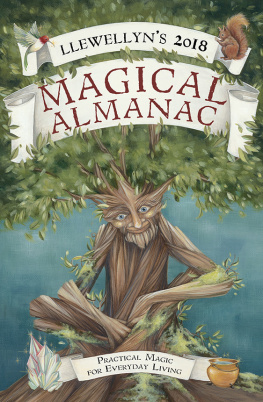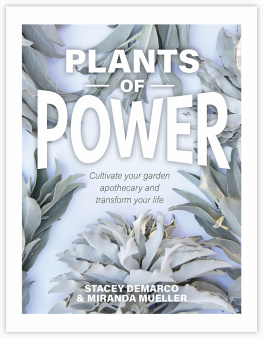Sandra Kynes is an explorer of history, myth, and magic. Although she is a member of the Order of Bards, Ovates and Druids, she travels a solitary Goddess-centered path through the Druidic woods. She likes to develop creative ways to explore the world and integrate them with her spiritual path, which serves as the basis for her books. Sandra has lived in New York City, Europe, and England. She now lives in coastal New England in a Victorian-era house with her family, cats, and a couple of ghosts. In addition to writing, she is a yoga instructor and Reiki practitioner. Sandra enjoys connecting with nature through gardening, hiking, bird watching, and ocean kayaking. Visit her website at www.kynes.net.

Llewellyn Publications
Woodbury, Minnesota
Copyright Information
Plant Magic: A Year of Green Wisdom for Pagans & Wiccans 2017 by Sandra Kynes.
All rights reserved. No part of this book may be used or reproduced in any matter whatsoever, including Internet usage, without written permission from Llewellyn Publications, except in the form of brief quotations embodied in critical articles and reviews.
As the purchaser of this e-book, you are granted the non-exclusive, non-transferable right to access and read the text of this e-book on screen. The text may not be otherwise reproduced, transmitted, downloaded, or recorded on any other storage device in any form or by any means.
Any unauthorized usage of the text without express written permission of the publisher is a violation of the authors copyright and is illegal and punishable by law.
First e-book edition 2017
E-book ISBN: 9780738751207
Book design by Bob Gaul
Chapter opening art by Wen Hsu
Cover design by Lisa Novak
Cover illustration by Chris Coccoza
Editing by Aaron Lawrence
Interior figures, oghams and runes by Llewellyn art department
Llewellyn Publications is an imprint of Llewellyn Worldwide Ltd.
Library of Congress Cataloging-in-Publication Data (Pending)
ISBN: 978-0-7387-5017-0
Llewellyn Publications does not participate in, endorse, or have any authority or responsibility concerning private business arrangements between our authors and the public.
Any Internet references contained in this work are current at publication time, but the publisher cannot guarantee that a specific reference will continue or be maintained. Please refer to the publishers website for links to current author websites.
Llewellyn Publications
Llewellyn Worldwide Ltd.
2143 Wooddale Drive
Woodbury, MN 55125
www.llewellyn.com
Manufactured in the United States of America
Contents
Please note that the contents are not meant to diagnose, treat, prescribe, or substitute consultation with a licensed healthcare professional. The publisher and the author assume no liability for any injuries caused to the reader that may result from the readers use of content contained in this publication and recommend common sense when contemplating the practices described in the work.
Introduction
The green world is enchanting and powerful, but unfortunately we spend so much time indoors and in cars that its easy to lose contact with nature. This makes it difficult to develop and maintain a working knowledge of plants.
Throughout the ages, witchcraft was intimately linked with plants. The witches, wise women and men, were the ones village people went to for medicine and magic. In addition to knowing what to use, they knew when plants came into leaf, bloomed, and produced seed or fruit. These people lived with the seasons. While we have the luxury of buying what we want whenever we want, change is afoot in the mundane world with a movement that focuses on seasonal and local food. For Pagans and Wiccans, this goes hand-in-hand with a spiritual path that celebrates the seasonal wheel of the year.
The sabbats form the spokes of this wheel, and there are certain traditional plants used to mark these occasions. But what about the time in between these metaphorical spokes? Of course its not devoid of plants because we use them for a range of magical purposes. However, the plants that we use dont always coincide with the cycle of the green world. Granted we can dry and store plants for later use as people have done for thousands of years, but how many of us know when to gather cinquefoil, sweet woodruff, or haws? Do we even know where to look for mullein?
Whether or not we garden or search the woods, the wisdom of plants comes alive when we work with them within the context of the seasons and learn how their cycles progress month by month. Basing our magical use of plants within the seasons also helps us develop more meaningful ways to connect with the green world and the realm of nature spirits. This, in turn, provides our rituals and magic with more continuity, creating a natural flow as we go through the year.
This book is a tool for learning about both ordinary and classically witchy plants. Going month by month, it highlights a range of plants from small herbs to mighty trees. Included are facts about the plants physical characteristics, its history and folklore, and how it can be used magically. While this book focuses on North American plants, we will see how plant mythology and folklore was often carried here by European settlers and applied to similar plants. In many cases, settlers brought plants with them to the New World.
The first chapter, Getting Started, provides information on connecting with the spirit and energy of plants, why scientific names are important, some frequently-used words that are good to know, and precautions about using and working with plants. We will also take a look at planetary and fixed star influences and, of course, the moons effect on plants for lunar gardening. Last but not least, we will see how the symbolism of the various parts of plants can be utilized.
Each subsequent chapter focuses on a month and is divided into four sections. The first section is called On the Calendar and takes note of sabbats, Celtic tree months, and other significant dates that involve plants. The next two sections are called In the Garden and In the Wild. These highlight plants that may be blooming or bearing fruit that month. As expected, these two sections are somewhat fluid as some wild plants have become popular in the garden and some garden plants have found homes outside of our backyards. The last section in each of these chapters is called In the House. This section focuses on indoor, plant-related projects and activities, though there is occasional overlap with the previous two sections.
This book provides a look at what is generally considered classical seasonal change, which is most closely mirrored in the Mid-Atlantic and Midwestern states. Of course, there are regional variations. I live in northern New England and our seasons lag behind many other areas of the country. However, the progression of development and growth and the interrelationship of plants follow the same cycle. Keeping notes on how the seasons unfold in your area will give you a sense of continuity throughout the year. Keep a journal of where and when you find plants in bloom and when they come into seed or produce fruit. Understanding and working with plants through the seasons reveals nuances that personalize our experience with the green world and helps to build our knowledge base for magic.













